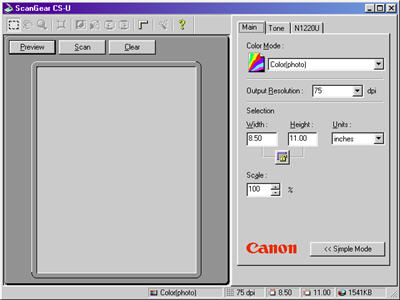Color Mode and Output (Scan) Resolution are key areas that can affect the scan quality.

Color Mode
This setting determines whether the scanned image is reproduced as a Black and White, Grayscale, Color (Photos), Color (Documents) or Text Enhanced image.
Select a Color Mode that corresponds to the scanned item and the purpose to which the scanned image will be put.
Top
Explanation of Color Mode Options
| Black and White |
Select this mode when outputting photos and other items to a monochrome printer. It expresses images in two colors, black and white. It uses a particular threshold value at which image data is either expressed as black or white, according to the brightness level. The threshold value can be adjusted. |
| Grayscale |
Select this mode to scan black and white photos or monochrome images. It expresses images in 254 shades of gray (grayscale) and black and white, making a total of 256 shades. |
| Color (Photos) |
Select this mode to scan color photos. It expresses images in 256 colors (8 bits) for each R(ed), G(reen) and B(lue) color channel. |
| Color (Documents) |
Select this mode to scan color documents that include text or charts in addition to color photos. It expresses images in 256 colors (8 bits) for each R(ed), G(reen) and B(lue) color channel. |
| Color |
Select this mode to scan color photos in greater detail. It expresses images in 65,536 colors (8 bits) for each R(ed), G(reen) and B(lue) color channel. |
| |
| Text Enhanced |
Select this mode to scan text more crisply, particularly to process it in an OCR program. It expresses images in two colors only, black and white. Scan with an Output Resolution between 300 dpi and 600 dpi.
This mode is not available in the Macintosh version. |
| * |
The Text Enhanced mode scans the item in grayscale and then converts the results to black and white, which takes longer to process than the Black and White mode. |
| |
|
Top
Output (Scan) Resolution
This setting selects the output resolution for the scan.
The scanner reads the item as a collection of points that possess varying brightness and color values. The density of these points is referred to as the "resolution" and measured as "dots per inch" (dpi). The higher the resolution, the finer the scanned image. The lower the resolution, the more granular the scanned image.
The following resolution options are available:75 dpi, 100 dpi, 150 dpi, 180 dpi, 200 dpi, 300 dpi, 360 dpi, 400 dpi, 600 dpi, 720 dpi, 1200 dpi.
In addition, a value ranging from 25 dpi to 2400 dpi can be entered directly in 1dpi increments. The values of 4800 dpi, 7200 dpi and 9600 dpi can also be entered directly.
Click Here for more information about 'Determining the Best Scan Resolution Settings'.
Top
_
_
_
_
_
_
_
_
_
_
_
_
_
_
_
_
_
_
_
The data in the image you have scanned is a collection of dots carrying information about brightness and color. The density of these dots is called ?resolution?, and ?dpi? (dots per inch) refers to the number of dots in one inch. Resolution will determine the amount of detail your image contains. The higher the resolution (number), the more detail in your image; the lower the resolution (number), the less detail. As a general rule, you should select a scanning resolution that corresponds to your final output device such as a monitor or printer.
To determine the best scan resolution for your project, the following categories will be helpful.
Images for display on a monitor
Images for printing
Printing to scale
Resolution and data size
You can specify the desired scanning resolution within the scanner driver.
Images for display on a monitor
Images for display on a monitor should in general be scanned at a resolution of 75 dpi.
Back
Images for printing
Images to be printed should be scanned at a resolution which corresponds to the resolution of the printer. For example, if you are using a 600 dpi black and white printer, you should scan your document at 600 dpi.
With a color printer, the colors are expressed as a certain percentage of ink pigment so scanning your document at half the resolution of the printer should be fine. For example, if you are using a 600 dpi color printer, you should scan your document at 300 dpi.
Back
Printing to scale
For example, if you want to print a document which is twice the size vertically and horizontally, the resolution of your document will be reduced by half. If the resolution of the original document is 300 dpi, the resolution of the enlarged document will be 150 dpi. If you print the document with a 600 dpi color printer, the lack of detail in the image may be obvious. In such a case, if you scan at a resolution of 600 dpi, resolution will be 300 dpi even if you double the size of the document and you can print the document with sufficient quality. Conversely, if you want to print a document at a reduced size, it should
be sufficient to scan at half the resolution.
Back
Resolution and data size
If you double the resolution, the image data will be four times greater. If the data is too large,
processing speed will slow down significantly, and you may experience malfunctions such as lack of memory. Make sure the resolution corresponds to the purpose of use of the image and set at the lowest level possible.
Back
_
Top